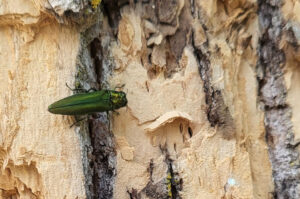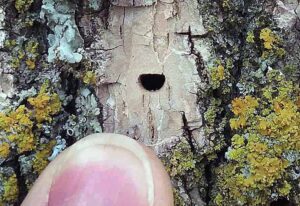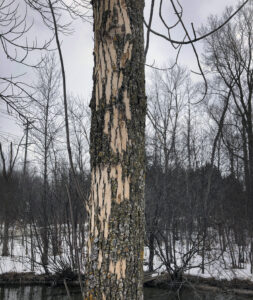By Art Kabelowsky, DNR Outreach and Communications, Fitchburg;
Arthur.Kabelowsky@wisconsin.gov; 608-335-0167

The emerald ash borer has been detected in Burnett County, making it the 72nd and final county in Wisconsin that have confirmed presence of the invasive insect. / Photo Credit: Paul Cigan, Wisconsin DNR
Sixteen years after the Wisconsin Department of Natural Resources (DNR) first detected emerald ash borer (EAB) in Wisconsin, the invasive beetle has been found in the last county without a previous detection.
Burnett County, in northwest Wisconsin, is the 72nd and final county to have a detection of the tree-killing pest.
DNR Forest Health staff responded to a report of EAB at a private residence in the Town of Meenon on June 13. Two trees on the property showed characteristic symptoms of EAB infestation, including tree decline and woodpecker “flecking” (visible damage caused by woodpeckers removing outer bark to eat the larvae beneath it).

An emerald ash borer larva carves a winding, S-shaped channel under the bark of an ash tree, preventing the distribution of water and nutrients to areas of the tree. / Photo Credit: Bill McNee, Wisconsin DNR
In July, insect specimens taken from the trees were confirmed as emerald ash borer by the United States Department of Agriculture Animal and Plant Health Inspection Service (USDA-APHIS).
The state’s first confirmed sighting of EAB took place in Ozaukee County in July 2008. Although the ash tree-killing beetle is less established in northwest Wisconsin than in other parts of the state, this year’s detections indicate that the pest is expanding its foothold in the region. EAB is most commonly transported to new areas when it hitches a ride inside firewood.
EAB larvae bore into ash trees and carve winding, S-shaped galleries beneath the trees’ bark, typically starting in the upper canopy and progressing down the tree. The galleries restrict the movement of water and nutrients to affected areas of the tree, leading to branch dieback, canopy thinning and tree death.
EAB is expected to eventually kill more than 99 percent of susceptible Wisconsin ash species (white, black and green ash and their ornamental varieties).
Wisconsin landowners should consider contacting a forestry professional or ISA-certified arborist and consult the state’s EAB resource page. Management options may include insecticide treatment of high-value trees and active forest management to reduce the impacts of EAB.

A D-shaped hole in a tree’s bark indicates that the tree is infested with emerald ash borer. Emerging adult beetles leave the telltale mark. / Photo Credit: Bill McNee, Wisconsin DNR
An immediate opportunity to reduce the insects’ impact may exist in parts of northern Wisconsin where EAB populations remain low. Landowners may enlist the aid of a forestry professional for suggestions on management approaches that could help to maintain healthy and productive forest conditions.
Dead ash tree trunks and branches are structurally weakened by EAB infestation and can become a serious safety hazard. Deer hunters seeking trees for deer stands are urged to stay away from any ash tree to avoid this risk.

Woodpeckers often peck away the bark of ash trees to feed on emerald ash borer larvae underneath. This activity, called “flecking,” is a strong indicator that an ash tree is infested with emerald ash borer. / Photo Credit: Bill McNee, Wisconsin DNR.
The Wisconsin Department of Agriculture, Trade and Consumer Protection (DATCP), which monitors the presence of EAB in Wisconsin, will continue to track the spread of the insect at the township and municipal level to inform management efforts to slow the pest’s spread into currently uninfested areas.
DATCP offers a website with more information about EAB and where it has been found. Those who discover a new EAB presence in their municipality can provide a report at that website.
DATCP has announced that no federal regulatory changes will result from the new detection. EAB was federally deregulated on Jan. 14, 2021; Wisconsin rescinded its state quarantine on July 1, 2023.
For more information, please visit the DNR’s web page on EAB and download the DNR’s fact sheet on EAB.
